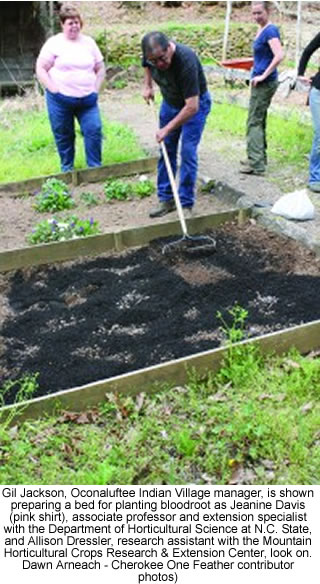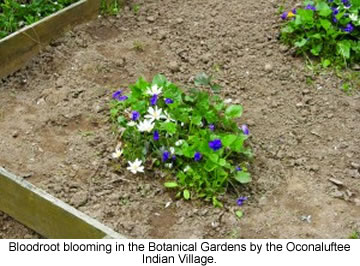 |
Canku Ota
|
 |
|
(Many Paths)
|
||
|
An Online Newsletter
Celebrating Native America
|
||
|
May 2013 - Volume 11
Number 5
|
||
|
|
||
|
Bloodroot the Subject
of Workshop
|
||
|
by Dawn Arneach - Qualla
Arts & Crafts
|
||
|
At the Village, Davy Arch, an EBCI tribal member who is the manager for the Botanical Gardens at the Village, took the group into the Botanical Area to plant. They started by sprinkling a lite dusting of lime and some compost, mixing and spreading this out evenly, putting holes six inches apart, and the roots planted. It may be three years before these will be ready for harvesting for dye material, but if it were to be used for medicinal use, it would be six years. Allison Dressler, a research assistant with the Mountain Horticultural Crops Research & Extension Center, commented, "It was inspiring to hear so many people already knew about the use of Bloodroot for a dye, but also that it is also known for its medicinal uses as well. To hear one basket maker share that she finds her bloodroot dyes darker on the full moon, than at other times, and then asked by another if we had the moon chart for dyes, which we don't, but that would make for another interesting project." On Friday, the planting group was supposed to work with Cherokee High School and Sara Thompson, but due to the rain it was moved to the following Tuesday. Visiting with teachers at the Kituwah Immersion School, they gave them a few of the Bloodroot kits. Special plantings were done at the houses of Shirley Taylor, Berdina Salazar and Annie James. A small plot was cleared of rocks, roots and debris, a mixture of lime and compost was added to the ground, then holes about six inches apart were made for the roots to be placed in. After covering the roots, some dry leaves or debris was placed on top to help retain moisture.
The workshop was overseen by Jeanine Davis, associate professor and extension specialist in the Department of Horticultural Science at N.C. State. Margaret Bloomquist, a research assistant with the Mountain Horticultural Crops Research & Extension Center, and Dressler did the main presentation about Bloodroot. Part of the project is compiling video footage, taken by Kelly Gaskill, of the workshop and the planting. The project is funded in part by the Cherokee Preservation Foundation.
Cherokee,
North Carolina |
|
|
||
|
|
||
| Canku Ota is a free Newsletter celebrating Native America, its traditions and accomplishments . We do not provide subscriber or visitor names to anyone. Some articles presented in Canku Ota may contain copyright material. We have received appropriate permissions for republishing any articles. Material appearing here is distributed without profit or monetary gain to those who have expressed an interest. This is in accordance with Title 17 U.S.C. Section 107. | ||
|
Canku Ota is a copyright ©
2000 - 2013 of Vicki Williams Barry and Paul Barry.
|
||
 |
 |
|
|
The "Canku
Ota - A Newsletter Celebrating Native America" web site and
its design is the
|
||
|
Copyright ©
1999 - 2013 of Paul C. Barry.
|
||
|
All Rights Reserved.
|
||
 For
two days, Bloodroot, a well-used dye for Cherokee artisans, was
a topic of conversation and action. The hows and whys of cultivating
your own personal crop was an hour long workshop, the first one
being at the Oconaluftee Indian Village. Questions included: where
best to plant, how much sunlight, watering, how far to plant the
roots apart, and preparing for the seeds were covered.
For
two days, Bloodroot, a well-used dye for Cherokee artisans, was
a topic of conversation and action. The hows and whys of cultivating
your own personal crop was an hour long workshop, the first one
being at the Oconaluftee Indian Village. Questions included: where
best to plant, how much sunlight, watering, how far to plant the
roots apart, and preparing for the seeds were covered.